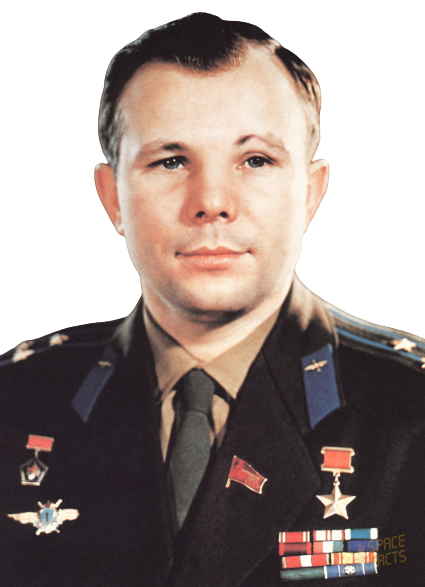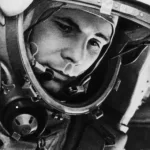
18.12.2022
On April 12, the world marks the 61st anniversary of the first human space flight. It was on this day in 1961 that the Soviet pilot Yuri Gagarin first saw the Earth from orbit.
That flight was truly a space flight: entering orbit with an apogee of 327 km, circling the Earth, and landing. In words, it looks like everything went smoothly, without a hitch. But in fact, the flight was accompanied by enormous risks and emergency situations. In honor of World Aviation and Space Day, The Universe. Space. Tech will tell you about the little-known facts about the first manned space flight.
The beginning of tradition
Even in the preparation phase, before he first boarded the Vostok 1 spacecraft, Yuri Gagarin took off his shoes. Because that is how the custom is to enter the house. By this act he showed his great respect for the spacecraft, which made a pleasant impression on chief designer Sergei Korolev.
Then during the trip by bus LAZ-695B “Lviv” to the rocket launching pad Yuri Gagarin asked to stop the car to go and urinate. He did it right on the wheel of bus – it became an obligatory tradition of all soviet and later Russian cosmonauts. And the need to cope exactly on the back right wheel.
A successful impromptu
The famous phrase “Let’s go!”, thrown by Yuri Gagarin before takeoff, was not pre-planned. This involuntary cry was in fact a successful impromptu, because it is remembered in history. The phrase can even be called a kind of “first space meme. However, there is a version of its origin: the flight training of a group of cosmonauts was headed by Mark Gallai, who used to say “Let’s go” instead of “Crew, take off” during training.
Fatal Risks
The first flight was subject to at least three deadly situations during which Yuri Gagarin could have died. First, an inaccurate flight task was mistakenly entered into the second-stage launch program. Therefore, the apogee of the orbit turned out to be higher than the calculated one by more than 100 km – 327 km instead of 230 km. The orbit was originally designed so that in case of braking engine failure, the ship would descend from it on its own within a week, slowing down in the atmosphere. From a higher orbit, this would have taken two months, and the air, food, and water supply on Vostok-1 would have been sufficient for only 10 days.
The second dangerous event occurred during re-entry. The crew compartment did not detach and was hanging on the cables. This caused a strong shaking inside “Vostok-1” and Gagarin experienced very strong overload, from which he almost lost consciousness. Fortunately, due to heat from friction in the atmosphere, the cables burned out and came off.
The third incident occurred before landing. Yuri Gagarin ejected at an altitude of 7 km and descended separately from the capsule. But after opening of the main parachute at an altitude of 2.5 km the “reserve” parachute accidentally opened, which miraculously did not extinguish the main dome. In addition, Gagarin barely managed to get the space suit breathing valve out from under the straps, so he almost suffocated. By the way, the landing itself could have happened not on land, but in the Volga River. Only throwing over 30 kg of “ballast” helped Gagarin to reach the necessary trajectory.
Height matters
The selection to the ranks of astronauts and the beginning of training took place in 1960. The first group, called the “Sochi Six”, consisted of 20 pilots. Yuri Gagarin and German Titov were the last two potential astronauts. And the strict selection was not only about their physical qualities and piloting skills. Low height was also an important selection criterion. Gagarin was only 1.57 meters tall, which was very important for being in the tiny cabin of Vostok 1.
Secret password
The effect of microgravity on the human body was not yet known. Therefore, the spacecraft was controlled remotely from Earth. But in case of an emergency, Yuri Gagarin was still able to switch to manual control of the spacecraft. For example, he could turn Vostok 1 independently and begin emergency braking to descend from the orbit. However, in conditions of oxygen deficiency, brain activity could be reduced, which increased the risk of pilot error. Therefore, Gagarin was asked to open a special envelope, read the secret password and enter it into the control panel. The procedure seems simple. But during hypoxia, doing such simple things becomes incredibly difficult. However, before the flight at least three people told Gagarin the secret password – “125”.
Brief Facts
Yuri Gagarin was the first person in human history to see Earth from space.
The space voyage lasted 108 minutes. During this time Vostok 1 completely circled the Earth, covering 41 thousand kilometers.
Before the flight Gagarin wrote a posthumous letter to his wife. In it he informed her that he most probably wouldn’t come back. He didn’t give her the letter. His wife found it after the cosmonaut came back home.
Until 1971, the USSR concealed the fact that Gagarin landed separately by parachute. Because in this case the flight could not be considered a space flight according to the rules of the International Aviation Federation.
Although Yuri Gagarin was a reserve pilot for further space flights, he was banned from returning to space. Because the party was afraid of losing its hero.
Gagarin died on March 27, 1968, during a training flight on a MiG-15UTI fighter jet.
Because of Yuri Gagarin’s mutual respect, the first men on the moon – Neil Armstrong and Buzz Aldrin – left a medal of the man who paved the way to space.




